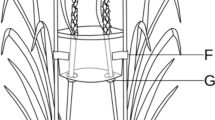Abstract
The study focuses on the odor-active intensity and occurrence of three methoxypyrazines in ladybird beetles, Harmonia axyridis, invasive in Europe and the USA, and Coccinella septempunctata, native in Europe, but invasive in the USA. It is known from previous studies that H. axyridis has negatively influenced the taste of wine in the USA because of releasing their hemolymph in must during harvesting. In relation to C. septempunctata, H. axyridis had more nitrogen containing compounds in its hemolymph and 2-isopropyl-3-methoxypyrazine (IPMP) and mainly 2-sec-buthyl-3-methoxypyrazine (SBMP) in higher amounts. The compound IPMP was detected as the main odor-active compound in both ladybird beetle species. Wines infested with hemolymph of C. septempunctata were more readily detected as altered wine with a ‘ladybird taint’ than wines infested with H. axyridis. 2-isobuthyl-3-methoxypyrazine (IBMP) could be identified as second intensive odor-active compound of C. septempunctata, which occurred in a much lower frequency in H. axyridis. SBMP, the second highest measured N-compound of H. axyridis, had a lower olfactory active threshold in gas chromatography–olfactometry test. C. septempunctata contained less SBMP in its hemolymph than H. axyridis. This study objected that besides H. axyridis also C. septempunctata can influence the taste of wine in a detectable way.



Similar content being viewed by others
References
Galvan T, Koch R, Hutchison WD (2008) Impact of fruit feeding on overwintering survival of the multicolored Asian lady beetle, and the ability of this insect and paper wasps to injure wine grape berries. Entomol Exp Appl 128:429–436
Riesen R (2008) Der asiatische Marienkäfer im Weinbau. Schweiz Z Obst-Weinbau 22:10–12
Cai LS, Koziel JA, O’Neal ME (2007) Determination of characteristic odorants from Harmonia axyridis beetles using in vivo solid-phase microextraction and multidimensional gas chromatography-mass spectrometry-olfactometry. J Chromatogr A 1147:66–78
Galvan TL, Burkness EC, Vickers Z, Stenberg P, Mansfield AK, Hutchison WD (2007) Sensory-based action threshold for multicolored Asian lady beetle-related taint in winegrapes. Am J Enol Viticult 58:518–522
Pickering G, Lin J, Riesen R, Reynolds A, Brindle I, Soleas G (2004) Influence of Harmonia axyridis on the sensory properties of white and red wine. Am J Enol Viticult 55:153–159
Pickering G, Ker K, Soleas G (2007) Determination of the critical stages of processing and tolerance limits for Harmonia axyridis for ‘ladybug taint’ in wine. Vitis 46:85–90
Ross CF, Rosales MU, Fernandez-Plotka VC (2010) Aroma profile of Niagara grape juice contaminated with multicoloured Asian lady beetle taint using gas chromatography/mass spectrometry/olfactometry. Intl J Food Sci Tech 45:789–793
Mohr HD (2005) Farbatlas Krankheiten, Schädlinge und Nützlinge an der Weinrebe. Eugen Ulmer KG
Cudjoe E, Wiederkehr TB, Brindle ID (2005) Headspace gas chromatography-mass spectrometry: a fast approach to the identification and determination of 2-alkyl-3-methoxypyrazine pheromones in ladybugs. Analyst 130:152–155
Al Abassi S, Birkett MA, Pettersson J, Pickett JA, Woodcock CM (1998) Ladybird beetle odour identified and found to be responsible for attraction between adults. Cell Mol Life Sci 54:876–879
Ullrich W, Grosch W (1987) Identification of the most intense volatile flavour compounds formed during autoxidation of linoleic acid. Z Lebensm Unters Forsch 184:277–282
Linder C, Lorenzini F, Kehrli P (2009) Potential impact of processed Harmonia axyridis on the taste of ‘Chasselas’ and ‘Pinot noir’ wines. Vitis 48:101–102
Kögel S, Gross J, Hoffmann C (2012) Sensory detection thresholds of ‘ladybird taint’ in ‘Riesling’ and ‘Pinot noir’ under different fermentation and processing conditions. Vitis (in press)
Galvan TL, Kells S, Hutchison WD (2008) Determination of 3-alkyl-2-methoxypyrazines in lady beetle-infested wine by solid-phase microextraction headspace sampling. J Agric Food Chem 56:1065–1071
Sala C, Mestres M, Marti MP, Busto O, Guasch J (2002) Headspace solid-phase microextraction analysis of 3-alkyl-2-methoxypyrazines in wines. J Chromatogr A 953:1–6
Savoiskaya GI (1970) Introduction and acclimatisation of some coccinellids in the Alma-Ata reserve. Trudy Alma Atinskogo Gosudarstvennogo Zapovednika 9:138–162 citated from Koch RL 2003
Koch R (2003) The multicolored Asian lady beetle, Harmonia axyridis: A review of its biology, uses in biological control, and non-target impacts. J Insect Sci 3:1–16
Gross J, Eben A, Mueller I, Wensing A (2010) A well protected intruder: the effective antimicrobial defense of the invasive ladybird Harmonia axyridis. J Chem Ecol 36:1180–1188
Acknowledgments
This work was supported by a grant from the ‘Forschungsring deutscher Weinbau’ (FDW). The authors thank the staff of JKI Grape-breeding Institut for support in vinification and wine tasting and the staff of JKI EPS Quedlinburg for sniffing. We thank Svenja Hoferer and Sabine Wetzel (JKI Dossenheim) for rearing the beetles. We are grateful to M. Paulus and C. Emmerling from the Trier University, Faculty VI, (Germany) for cooperation.
Author information
Authors and Affiliations
Corresponding author
Rights and permissions
About this article
Cite this article
Kögel, S., Gross, J., Hoffmann, C. et al. Diversity and frequencies of methoxypyrazines in hemolymph of Harmonia axyridis and Coccinella septempunctata and their influence on the taste of wine. Eur Food Res Technol 234, 399–404 (2012). https://doi.org/10.1007/s00217-011-1646-y
Received:
Revised:
Accepted:
Published:
Issue Date:
DOI: https://doi.org/10.1007/s00217-011-1646-y




